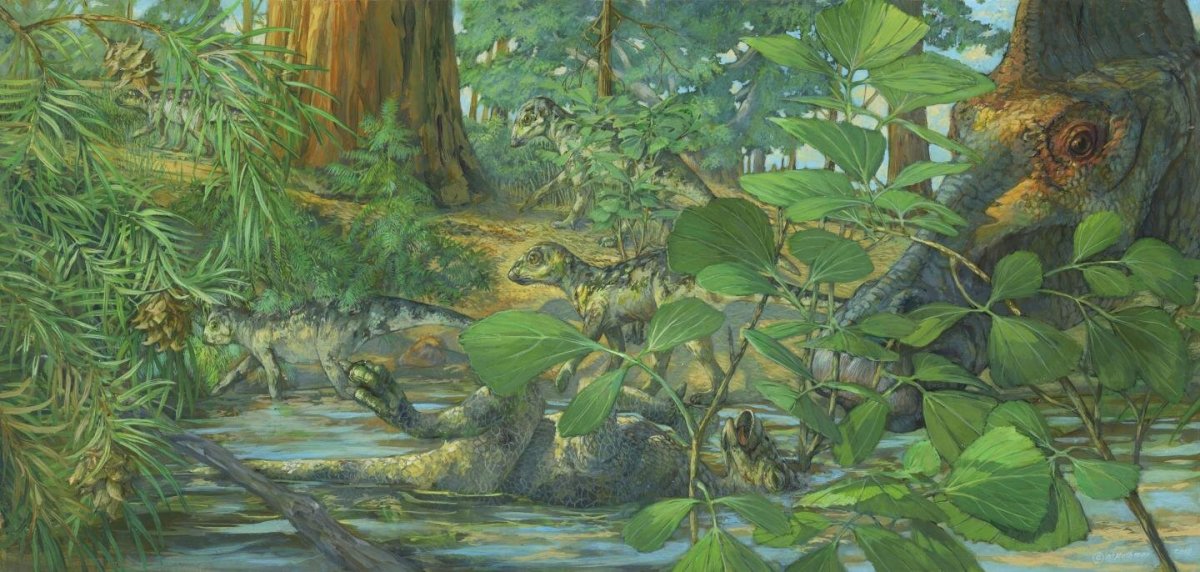Palaeontologists have announced the discovery of organic material in 75-million year old dinosaur fossils. The team claims to have found evidence of cartilage cells, proteins, chromosomes and even DNA preserved inside the fossils, suggesting these can survive for far longer than we thought.
The researchers, from the Chinese Academy of Sciences and North Carolina State University, made the discovery in skull fragments of Hypacrosaurus, a duck-billed herbivore from the Cretaceous period. These particular specimens were “nestlings”, meaning that at time of death they weren’t yet old enough to leave the nest.
Inside the skull fragments, the team spotted evidence of extremely well-preserved cartilage cells. Two of them were still linked in a way that resembles the final stages of cell division, while another contained structures that look like chromosomes.
The next step was to check whether any original molecules or proteins could still be preserved, and to do so the team conducted two detailed analyses on other skulls from the same nesting ground, and compared the results to samples from young emu skulls that are (obviously) much more recent.
The first was an immunological test, which involves applying a substance that will react if it detects antibodies from a particular cell type. In this case, the test reacted to antibodies of Collagen II, a protein commonly found in the cartilage of animals. This, the team says, suggests that remnants of the original proteins are still present.

Science China Press
Understandably, the reaction was far fainter for the dinosaur samples than the emus. The dinosaurs’ staining was also localized in one spot, where as in the emu it was spread across the whole sample.
In the second test, the team hunted for dinosaur DNA. They isolated individual cartilage cells from the Hypacrosaurus, and applied two different staining substances that bind to DNA fragments. And sure enough, the staining occurred in the same pattern expected for modern cells.
The implications of potentially finding DNA in these samples are huge. Current thinking says that DNA can only persist for about a million years maximum – but these fossils are 75 million years old.
“These new exciting results add to growing evidence that cells and some of their biomolecules can persist in deep-time,” says Alida Bailleul, co-lead author of the study. “They suggest DNA can preserve for tens of millions of years, and we hope that this study will encourage scientists working on ancient DNA to push current limits and to use new methodology in order to reveal all the unknown molecular secrets that ancient tissues have.”

Science China Press/Michael Rothman
Of course, discoveries that completely shake up our understanding of biology can’t be taken lightly, and in the past similar findings have attracted their share of criticism. Dr. Mary Schweitzer, who was co-lead author on this new study, has previously made headlines in 2007 for finding proteins and other soft tissues preserved in a Tyrannosaurus rex femur.
But other scientists rallied against the bold claim. Some argued that the data was misinterpreted, while others suggested that bacterial biofilms, formed while the fossils were still in the ground, could have looked similar under the microscope. Another study found that the dinosaur samples may have been contaminated with ostrich DNA in the lab where they were examined.
That said, the researchers on the new study seem to have pre-empted some of these arguments. They point out that Collagen II isn’t produced by microbes, so bacterial biofilms wouldn’t cause the tests to come back positive. Biofilms would also create very different patterns in the DNA staining tests than what was seen here. And finally, the team says that the comparisons to emu samples were conducted in completely different labs, so there was no chance of cross-contamination.
While Jurassic Park remains firmly in the realm of fiction, the possibility that dinosaur DNA and organic molecules could persist for tens of millions of years is still fascinating, and it could teach us far more about these captivating, ancient creatures.
The research was published in the journal National Science Review.
Source: Science China Press via Eurekalert














